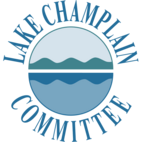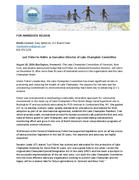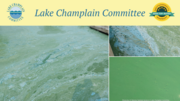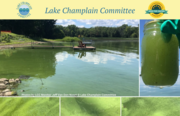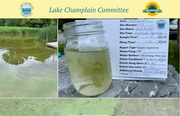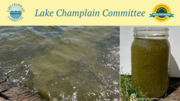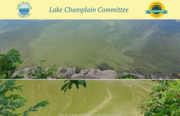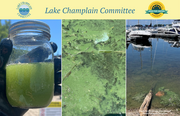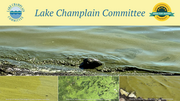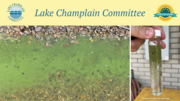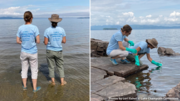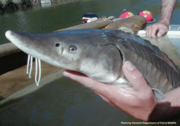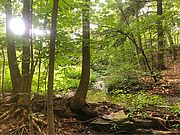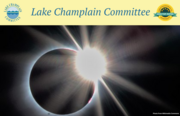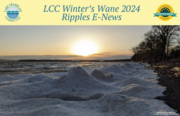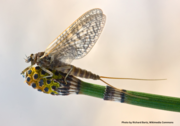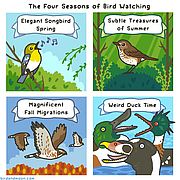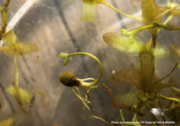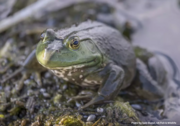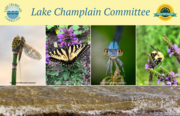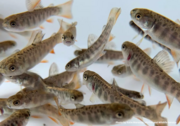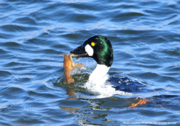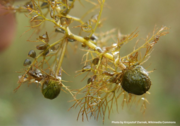The Lake Champlain Committee of Vermont, New York, and Quebec announced today that Lori Fisher, its esteemed Executive Director, will retire on December 31 after more than 30 years of dedicated service to the organization and the Lake Champlain Basin.
Under Fisher’s leadership, the Lake Champlain Committee has made significant strides in protecting and restoring the health of Lake Champlain. Her passion for the lake and her unwavering commitment to environmental stewardship have been key to advancing LCC’s mission. Read...
It was another week of highly variable conditions depending upon where you were. Monitors filed 240 reports during week 9 and 19% were of blooms. The majority came from northern sections of Lake Champlain. Some blooms persisted for days and continued into week 10. The many bloom reports also delayed the compilation and sending of our weekly email. LCC does roughly 90% of the report vetting and follow-up with monitors so our report to you goes out later during high traffic weeks. Read...
Some extensive and persistent blooms were experienced in northern sections of Lake Champlain and various inland waterways including the Poultney River during week 8 of monitoring. Big thanks to all the community science volunteers who are chronicling conditions. Cyanobacteria monitoring will continue through the fall so click here if you’d like to join the 2024 cyanobacteria monitoring team.
Read...While most monitors reported generally safe conditions during their week 7 site rounds, those that did observe blooms often found them widespread. And blooms certainly weren’t restricted to Lake Champlain – VT inland waterways of Lake Carmi, Shadow Lake, and the Moore Reservoir all had significant blooms. In this email you’ll find details on weekly conditions, resources to help you recognize cyanobacteria, along with photographs of Gloeotrichia sp.; spinach smoothie look-alikes; bloom gloom at Lake Champlain sites at Venise-en-Québec QC, Philipsburg QC, Macomber Point in the Inland Sea VT, Niquette Bay VT; and inland lake VT sites at Lake Carmi, Shadow Lake, and Shelburne Pond. Read...
While many monitors reported bloom-free conditions during week 6, where cyanobacteria did show up it sometimes persisted for several days. In this email you’ll find details on weekly conditions; resources to help you recognize, avoid and report cyanobacteria; and photographs of week 6 bloom zooms, high alerts at Stephenson’s Point VT and Philipsburg QC, a low alert at Lake Carmi, khaki-colored blooms, clumps of blooms, Gloeotrichia sp. – a colonial cyanobacteria, tools of the trade, clear water scenes, and parting shots tracking a bloom. Read...
Monitors weathered another week of IT challenges as the tech issue that shut systems down worldwide also affected the cyanobacteria tracker. It’s the reason you’re getting this weekly compilation of results much later than usual. Many LCC monitors had to delay filing reports due to the IT problem so there was a backlog of assessments to enter and vet once the tracker was working again. Read...
It was eerily familiar last week as floodwaters wreaked havoc on infrastructure, communities, and ecosystems, exactly a year after the historic July 2023 flooding. We hope you didn’t personally endure damage but know everyone in the watershed is affected as we witness the devastating effects of another high intensity storm. Some monitors were unable to access their sites due to washed out roads and some sites are closed due to damage. Read...
Hot weather during the 4th of July holiday led to a burst of blooms and the cyanobacteria tracker went down over the weekend making for a challenging week! Please read on for June 30 – July 6, 2024 monitoring results and resources to help you recognize, avoid and report cyanobacteria. Read...
With summer in full swing, the native aquatic plants in Lake Champlain are spreading and blooming, adding pops of color to the water. How did they get here, and what helps make them successful away from land? Read...
Happy summer! Thank you for signing up to receive the Lake Champlain Committee (LCC) Cyanobacteria monitoring reports! Each week we’ll send you an update about conditions monitors are finding on Lake Champlain and at select inland Vermont lakes. Monitoring began the week of June 16 and will run through early fall. This week’s report covers results from Sunday, June 23 through Saturday, June 29, 2024. Read...
Thank you for signing up to receive the Lake Champlain Committee (LCC) Cyanobacteria monitoring reports! Monitoring began the week of June 16 and will run through early fall. Each week we’ll send you an update about conditions monitors are finding on Lake Champlain and at select inland Vermont lakes. This week’s report covers results from Sunday, June 16 through Saturday, June 22, 2024. Read...
Lake Champlain is abuzz this time of year. Aquatic plants leaf out and spread, insects dance along the water’s surface, and people flock to the beaches. All this activity brings to light not only the many things we love about the lake, but also the challenges we face in maintaining its water quality and ecological integrity: it’s the season of cyanobacteria blooms and invasive species spread. With that, it’s the “on-season” for LCC's on-the-water stewardship programs. Read...
The lake sturgeon is a fish with a lot of superlatives. It’s as long as the standing height of an adult man, with longer recorded lifespans than humans. It has been on earth since before the evolution of flowering plants. And it has a complicated relationship with people as it was nearly driven to extinction and is currently designated as endangered in Vermont and threatened in New York. Read...
Do you live near a stream? Is there a healthy vegetated buffer around the stream that runs through your property? If you answered yes, you might be Stream Wise!
Stream Wise awards and recognizes private landowners that maintain wide buffers of native plants along river and stream shoreland to promote water quality and stream resiliency. Maintaining a healthy vegetated buffer around streams helps reduce the amount of runoff that enters our waterways, which is important for water quality. These buffers are also key wildlife habitat.
Fill out our sign-up form and LCC will reach out to schedule an assessment. Read...
On Monday April 8, 2024 the skies above Lake Champlain will go dark in the middle of the afternoon. Almost all of the lake is in the path of totality for the solar eclipse of 2024 passing through Mexico, the US, and Canada. It’s a historic occurrence—on average, any given location sees a total solar eclipse every 355 years. The LCC team is excited to experience this rare celestial event and will be heading out on foot to various viewing locations in the Lake Champlain watershed. Read on for information and resources about what a solar eclipse is, where to go, where not to go, Leave No Trace principles, a solar eclipse sundial, safety, community science opportunities, regional guides, and more to help you experience this once-in-a-lifetime phenomena. Read...
With no concept of weeks, months, or daylight savings—frogs and salamanders rely entirely on environmental cues of temperature and precipitation to tell them when it’s time to start their vernal lifestyle. What does this seasonal shift look like, and how have humans affected it? Read...
Read on to see what LCC and Lake Champlain have been up to lately! Read...
Stormwater runoff poses a major challenge for water quality in Lake Champlain. When rain falls on impervious surfaces, it does not have the chance to infiltrate into the ground and instead flows over roofs, parking lots, and roads—collecting pollutants and nutrients along the way—until it eventually reaches the lake, untreated. Runoff from developed land contributes more phosphorus to Lake Champlain than any other land use type per area. Read...
For about as long as we have had agriculture, we have had agricultural pests—insects and other creatures who make their living off food we grow. We’ve been in an evolutionary showdown with these pests for centuries, adapting new technologies to better protect our food. The stakes of the back and forth increased dramatically with the advent of chemical pesticides. In the 1980’s, a specific class of pesticide was developed called neonicotinoids, or “neonics”. Read...
The changing of the seasons in the Lake Champlain Basin brings new wonders to the avian world. Cartoonist, writer, avid birder, and graduate of the University of Vermont’s Field Naturalist Program Rosemary Mosco broke down the four seasons of bird watching in the Northeast US: Elegant Songbird Spring, Subtle Treasures of Summer, Magnificent Fall Migrations, and the season we are now in—Weird Duck Time. Read...
While the winter of 2024 has been unseasonably warm, we still needed to turn on the heat and don extra layers to adjust to the seasonal change. But what about the lake’s vegetative life? How have the native aquatic plants of Lake Champlain evolved to survive winter? Read...
American bullfrogs (Lithobates catesbeianus) are deeply associated with spring and summer–their deep “jug-o-rum” serenade evokes images of hot summer nights: fireflies, and leafed-out trees. But what are they up to during cooler times? As with all living things in the Lake Champlain region, bullfrogs need to adapt to the winter season, and as aquatic amphibians, many do this in the lake itself. Read...
Sincere thanks to our wonderful team of cyanobacteria monitors and partner organizations for diligently checking Lake Champlain and inland lake locations during the 2023 season. Monitors collectively filed nearly 3,000 reports over a 19-week period. Read...
We don’t often give surface water much thought on its journey after it enters a storm drain–out of sight, out of mind. But the health of the waters going through storm drains is intrinsically tied to the health of all of our waters. It’s a common misconception that storm drains usually lead to wastewater treatment plants. In reality, most of this water is directly discharged into nearby waterbodies, and in the Lake Champlain basin, that means it eventually winds up in the lake. Read...
LCC is working with a coalition of partners in support of Vermont legislation to protect pollinators and water ecosystems by dramatically curtailing the use of “neonics”. H.706 would phase out up to 90% of neonics over the course of the next five years, with certain emergency exemptions for farmers. Help get this bill passed by contacting your state reps today and asking them to support H.706. Read...
Dozens of beekeepers, students, conservationists, environmental advocates, and pollinator enthusiasts of all sorts gathered at the Vermont State House today to make the case for providing greater protections for pollinators and aquatic ecosystems. “Not only do neonic pesticides lead to die offs of honeybees, wild pollinators, and birds, they also leach into groundwater and wash into surface waters with precipitation,” stated Lori Fisher, Executive Director of LCC. “This degrades water quality and harms aquatic insects, particularly mayflies and damselflies. These and other invertebrates are vital species that are a cornerstone of a healthy aquatic ecosystem.” Read...
March 2024 - Neonicotinoids, or "neonics" are versatile chemical pesticides that can be treated on a plant’s seeds so they’re built into the plant as it grows. As research continues to emerge on the harms that this class of chemicals has to the ecosystem beyond their targets, we need to seriously reconsider this practice and stop using these pesticides. Read...
What effect did the floods of Summer and again in December in 2023 have on fish? We talked with Will Eldridge from Vermont Fish and Wildlife to see what these floods did for fish from the headwaters to the lake. Read...
The four seasons of bird watching in the Northeast US: Elegant Songbird Spring, Subtle Treasures of Summer, Magnificent Fall Migrations, and the season we are now in—Weird Duck Time. Read...
The time of year for winterization is upon us: we seal windows, run heaters, open boxes of coats and mittens, and dust off sleds and skis. These are all strategies that humans in colder climes like the Lake Champlain basin employ for winter survival and enjoyment. But what about the lake’s vegetative life? How have the native aquatic plants of Lake Champlain evolved to survive winter? Read...
